View as PDF
View this email on our site
Subscribe to this newsletter

Please consider sharing this newsletter with others.
Expect Pest Encounters as School Buildings Reopen
Dawn H. Gouge1, Tim Stock2, Jennifer Weber1, Janet Hurley3, Shaku Nair1, Shujuan Li1 1University of Arizona, 2Oregon State University, 3Texas A&M AgriLife Extension.
In this Issue
But first – Congratulations to Faculty & Staff

We saw how hard you worked to support and educate students through the end of the 2019-2020 academic year.
You are appreciated!
Pandemic Pest Resurgence - Preparations Before Opening
Prior to March 2020, 97% of the nation’s 60 million K-12 students received their education on school campuses. Mid-March about 131,000 school campuses closed suddenly to slow the spread of the novel coronavirus SARS-CoV-2.
School faculty and staff had little or no time to undertake the usual end of year class clear-outs and deep cleaning. Landscape and maintenance staff were also limited or prevented from undertaking normal campus duties.
As the 2020-2021 academic year begins some campuses are beginning to open for in-class operation after more than five months of closure. Some campuses are likely to remain closed for some time to come. But pests on campus have already been given ample time to invade structures and landscape and increase in numbers.
If you are returning to campus, ask your facility manager what reopening preparations have been undertaken. Here are a few things to ask about or undertake if you are the person responsible for reopening your campus even if operations are reduced or occupancy is limited:
Not all pests thrive without us
Some pests are particularly dependent upon the resources we normally provide.
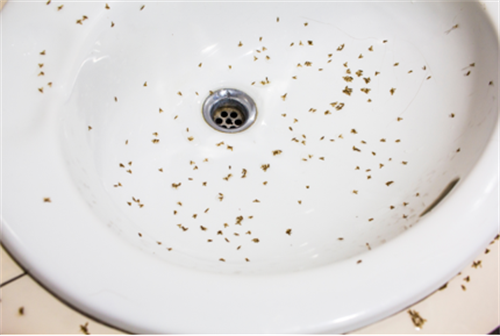
Drain flies flourished then died as the organic matter in an unused sink dried up.
German cockroaches, filth flies like house flies and drain flies will die quickly if they do not have ongoing access to water or moist environments. There could be piles of dead insects in places where they flourished then died as moisture resources dried out.
But plenty of pests will take advantage of empty campuses
Opportunistic dumpster divers are common under normal operations and even if school sites were able to maintain access for solid waste removal before campus closure, residents in surrounding neighborhood may have deposited waste in school dumpsters that were no longer emptied. Look for birds, rats, North American raccoons, Virginia opossums. Unfortunately, as some animal shelters reduced operations, and the hardest hit families go through evictions more neighborhood pets have become campus visitors.
Indoor invaders may be prevalent. Some ant species are remarkable building intruders with amazing abilities to find food. Many sensing low-volatility chemicals that humans can not perceive. Argentine and odorous house ants will forage on sweets and oily foods. Crazy, fire, thief, pavement and carpenter ants are omnivorous, feeding on both dead and live insects, fruits, seeds, meats, and grease.

School buildings may provide ample supply of food for pests.
Dead indoor insects may indicate entry points by which invading pests like crickets and outdoor cockroaches wander in to die. Revisit these areas to seal pest entry points as soon as possible.
American cockroaches commonly enter through floor drains as below ground drain P-traps dry up and are commonly found dead or dying in high numbers inside school buildings after normal summer closures.
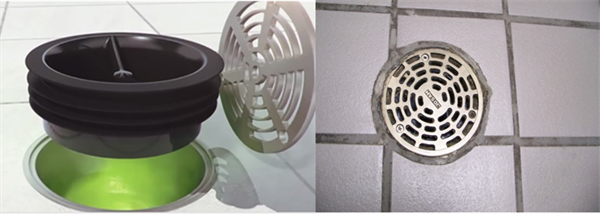
Trap-Guard™ or GreenDrain fittings prevent troublesome drain issues.
Indoor infesters may be prevalent. There are many different stored product pests. Food supplies may be infested by pests gaining access to the resource by tunneling through packaging. Some food will arrive with small numbers of insects already inside that reproduce rapidly. For both reasons, food should be stored in airtight containers, refrigerated or frozen. If beetles or moths are found in kitchen or storage areas, carefully inspect bulk food items for infestations.

Baker’s bins are commonly used in school kitchens and do not seal pests in or out.
Commensal rodents like house mice, roof or Norway rats can be particularly problematic. House mice reproduce rapidly, requiring little or no water. All they need is food and shelter. Female mice can reproduce at 6 weeks of age and can give birth to 7 or 8 pups every 5-6 weeks year-round.
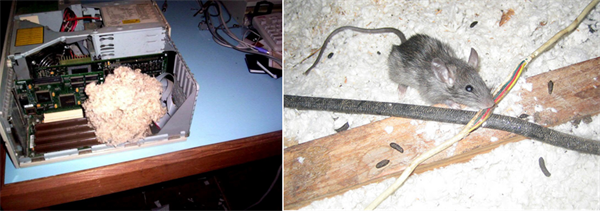
Rodents can cause costly damage to equipment and structural wiring.
Attics can be vulnerable to pests entering through soffit and roof vents, eave gaps, and exhaust fans (mushroom-type roof vents). Flat roofs often have raised parapet walls around the roof edge, and these are often hollow with flashing or sealant materials connecting parapet walls and roofing. Attic areas should be checked for roof rats, mice, rock squirrels (southwest), flying squirrels (eastern and northwestern states), bats, raccoons, opossums. Birds and honey bees may also set up home in attic spaces.
Campus grounds may or may not have been maintained to the usual standard and the use of outdoor areas for teaching may make these areas frequently used school zones. It is more important than ever to maintain these areas free of stinging insects like honey bees, wasps and fire ants, as well as disease vectors like mosquitoes and ticks.
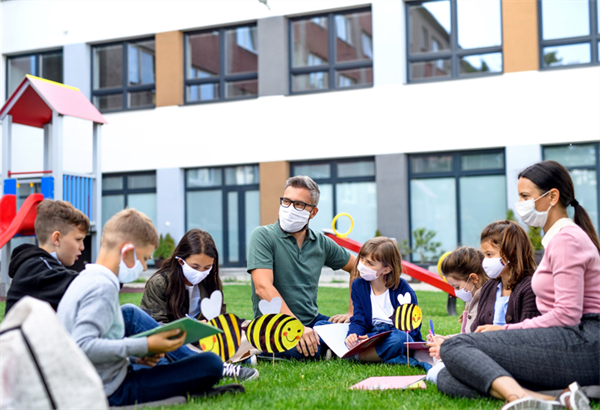
Outdoor classroom areas must be free of stinging insects and disease vectors.
Never Mix Disinfectants
Handle disinfectants with care. Many commonly used chemicals can cause severe eye damage, skin injury and breathing problems. Here are a few tips to remember:
If a medical emergency occurs while disinfectants are being used, call 911 and notify first responders of the products involved.
If a non-emergency exposure occurs, call the poison help line.
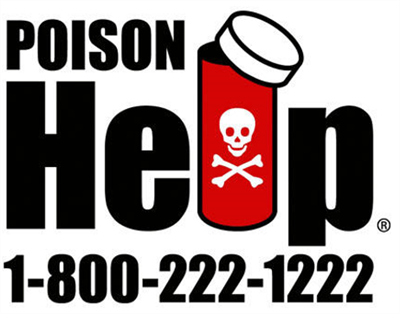
The National Pesticide Information Center can offer general guidance on disinfectant use. Call 1.800.858.7378 or email npic@ace.orst.edu. NPIC is open 8:00AM to 12:00PM Pacific Time, Monday-Friday.

Resource Sites for Schools
Readiness and Emergency Management for Schools Technical Assistance Center. School and university systems are entrusted to provide a safe and healthy learning environment for students, faculty, and staff members. The U.S. Department of Education’s Office of Safe and Supportive Schools has administered the Readiness and Emergency Management for Schools (REMS) Technical Assistance (TA) Center to serve two critical functions aimed at helping education agencies with their community partners, manage safety, security, and emergency management programs.
The REMS TA Center website houses guidance, resources, training, and tools in one centralized location on COVID-19 and infectious disease planning activities for education facilities. Now more than ever we appreciate that emergency preparedness planning is a critically important component of school management. Check out the site: https://rems.ed.gov/.
School reopening plans are posted and updated here: https://tinyurl.com/yymqqtqe.
EPA Coronavirus main page: https://www.epa.gov/coronavirus.
List N: Disinfectants for use against SARS-CoV-2: https://tinyurl.com/y9668r62.
The Collaborative on Health and the Environment (CHE) is a network that cultivates a learning community based on the latest, evidence-based science to share knowledge and resources, and improve individual and collective health. The CHE also has an environmental health educational website called Because Health https://www.becausehealth.org/ that focuses on making environmental health more accessible. They recently released tool kits that summarize best practices from the CDC, EPA, and other environmental health scientists and experts:
Safer Cleaning and Disinfectant Use During Coronavirus for Early Childcare Providers and Schools https://tinyurl.com/y47ywgyj.
Water Quality During Coronavirus for Childcare Facilities and Schools https://tinyurl.com/y6qorj28.
CHE also provides webinars on COVID-19 https://tinyurl.com/y5mkbkq8.
Read the Pacific Northwest OSHA Education Center Blog on Safer Chemicals in the time of COVID https://tinyurl.com/yxuul2tw.
Assess, then Address - Check out the EPA School Indoor Air Quality (IAQ) Assessment Mobile app: a “one-stop shop” for accessing EPA’s comprehensive school IAQ management guidance and detailed walkthrough assessment checklists that address critical building-related environmental health issues https://tinyurl.com/y3llpcdh.
For more information about the EPA Schools program see http://www.epa.gov/schools/, and for information on upcoming Integrated Pest Management Webinars see: https://tinyurl.com/y3hdkkw7.
To view previous newsletters: https://tinyurl.com/y5hm78g5.
We have been aware of the truly heroic efforts of teachers, university instructors, school and university staff across the nation. Those invested in education have worked tirelessly throughout the COVID-19 pandemic to support students, families, and their communities. Thank you.
Acknowledgements
This material is in part funded by the National Institute of Food and Agriculture, U.S. Department of Agriculture, under award number 2017-70006-27145 that provides Extension IPM funding to the University of Arizona. Additional support is provided by the U.A. – Arizona Pest Management Center.
